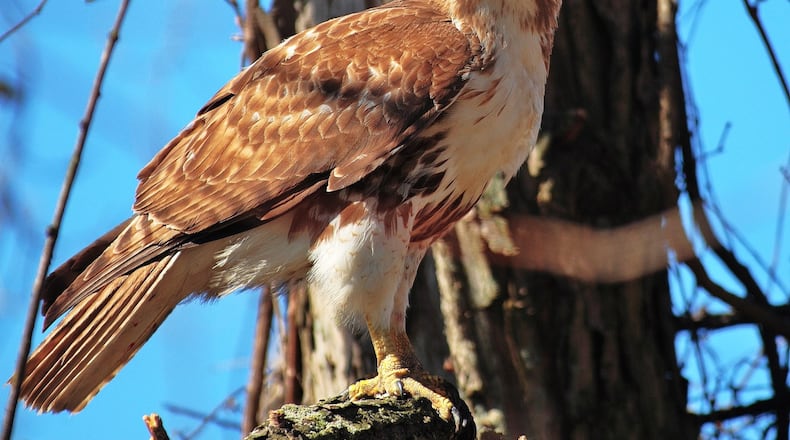I was birding the other day in the Clyde Shepherd Nature Preserve in Decatur when a burst of activity in the cloudless sky above me caught my eye. Two red-tailed hawks seemed to be dive-bombing each other.
It was not aerial combat, I quickly realized. It was a pair of red-tails performing their dazzling courtship act, one of nature’s grand spectacles. March is prime breeding time for the red-tailed hawk, which is Georgia’s most common hawk species.
I had seen red-tails performing variations of their courtship routine before, but this time I got a more extended, thrilling version. A red-tailed hawk courtship usually begins with a pair of birds soaring in wide circles high in the sky. Then, after making a series of dives and ascents, the male approaches the female from above and gently touches her with his outstretched legs — and sometimes grasps her.
I had seen that part before, but this time the birds above me did something I had not seen until then: They locked talons and beaks and began spiraling and tumbling at great speed toward the ground. Just when they appeared headed for a crash, they broke apart and flew away unharmed. All through this, they emitted raspy calls and piercing screams that sounded like kleeyeeeeer.
After a few more minutes of flapping about, one of the birds (the female, I presume) disappeared behind some tall trees, presumably to wait for the male to show up and mate.
Nesting will come next, I presume. Red-tailed hawks, named for their distinctive, reddish, unbarred tails, build large stick nests — or renovate old ones — usually in large trees in open areas. They are more likely to nest in wooded residential neighborhoods than other hawks. The female lays 2 to 3 eggs that hatch in about a month. The baby birds leave the nest within about 45 days but remain near their parents for about four more weeks.
IN THE SKY: From David Dundee, Tellus Science Museum astronomer: Venus and Mercury are low in the west just after dark and will appear close together on Monday. Jupiter rises in the east just before midnight and will appear near the moon on Tuesday. Mars and Saturn rise out of the east about an hour after midnight. Mars will appear near the moon on Friday night.
About the Author
Keep Reading
The Latest
Featured


